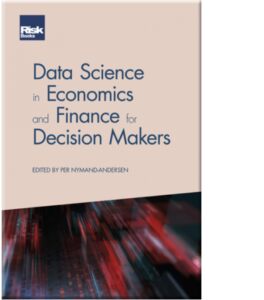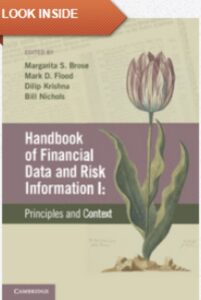Data Science in Economics and Finance
for Decision Makers

This is what people say:
Hal Varian, Chief economist at Google
“Per Nymand-Andersen has assembled a “guide for the perplexed” that emphasizes the practical applications of data science for managers. It provides an excellent overview of the subject matter in clear and easy to read prose and will prove useful to anyone seeking an introduction to data science.”
Peter Praet, Chief Economist and former member of the Executive Board, European Central Bank
“This book gives a comprehensive overview of how the digital transformation is supporting decision-making under uncertainty, what future developments we can expect and what are the conditions for success. It provides a collection of essays combining analysis and concrete cases.
I strongly recommend this book, which gives a multifaceted perspective on the use of big data in policymaking.”
Jaime Caruana, former Governor of the Bank of Spain, General Manager of the Bank for International Settlement
Making sense of the wealth of available data, connecting the dots instead of merely collecting them, is the key challenge. Data Science in Economics and Finance for Decision Makers is a welcome book, shedding light on these complex issues. It provides a clear and comprehensive overview of the opportunities offered by data science, drawing from concrete use cases. Practical. Accessible Insightful. A must-read.”
William White, former chairman of the Economic and Development Review Committee at the OECD
“Economies are complex, adaptive systems full of heterogeneous agents whose interactions have thus far been almost impossible to discern. This book, highly multidisciplinary in character and totally comprehensive in scope, offers essential insights to both practitioners of data science and the policy makers who increasingly depend upon them. It excites by suggesting how new techniques such as artificial intelligence can advance our understanding of systemic processes while also improving policy and the communication of policy. A ‘how to’ guide to the future of data and modelling that will stimulate engineers, data scientists, lawyers and philosophers as well as central bankers and financial regulators.”
You can buy this book: Data Science in Economics and Finance – Risk Books
Google econometrics:
Nowcasting euro area economic using big data

“Big data” is becoming an increasingly important aspect of our daily lives as the digital sources of information and intelligence that it encompasses become more structured and more publicly available. These sources may enable the generation of new datasets providing high-frequency and timely insights into unconscious digital behaviour and the consequent actions of economic agents, which may, in turn, assist in the generation of early indicators of economic and financial trends and activities. This paper examines the usefulness of Google search data in nowcasting euro area car sales, as a leading macroeconomic indicator, and proposes a quality framework for using these new data sources as a toolkit for sound decision and policy making..
Download the paper here: Google econometrics: nowcasting euro area car sales and big data quality requirements (europa.eu)
Yield curve modelling and a conceptual framework:
Evidence from the European Central Bank

The European Central Bank (ECB), as part of its forward-looking strategy, needs high-quality financial market statistical indicators as a means to facilitate evidence-based and sound decision-making. Such indicators include timely market intelligence and information to gauge investors’ expectations and reaction functions with regard to policy decisions. The main use of yield curve estimations from an ECB monetary policy perspective is to obtain a proper empirical representation of the term structure of interest rates which can be interpreted in terms of market expectations of monetary policy, economic activity and inflation expectations over short-, medium- and long-term horizons.
Yield curve modelling and a conceptual framework for estimating yield curves (europa.eu)
Handbook of Financial Data and Risk Information I
Financial data and risk information needed for the
European System of Financial Supervision

Europe’s Economic and Monetary Union (EMU) is a unique construction with no other historical example. On January 1, 1999, the single monetary policy for the euro area as a whole was implemented by the ECB and the participating national central banks, whereas economic policy was largely left at the national level. The lessons learnt from the impact of the financial crisis have demonstrated the need to safeguard both the micro-prudential and macro-prudential supervision of the European financial system and, at the same time, to move forward with further coordination of economic policies at the European level to ensure that sufficient coordinated rules and actions with an appropriate response time for mitigating risks are in place and to guarantee that sustainable economic policies are in line with a prudent Economic and Monetary Union. This contribution focuses primarily on the new European financial supervisory architecture including new European authorities for safeguarding the financial system. Europe is on the right path towards a banking union building upon a macro-prudential and micro-prudential pillar.
Handbook on Systemic Risk
The new financial stability framework in Europe

The financial crisis has demonstrated the need to rethink the conceptual approach of risk and data collection within the financial sector, by taking a holistic, economic and financial system wide perspective. This chapter provides an overview of the new challenges to manage systemic risks in the European financial system, focusing on the required macro- and micro level statistics and the new institutional and conceptual framework for identifying systemic risk and calls for further research to understand the behavioural aspects of decision making and herding effects in financial markets and to look beyond traditional economic theory, which seems to have failed to predict the size, magnitude and the contagion effects of the recent financial crises. Despite the fact that it is too early yet to judge the performance of the new financial stability framework, the set-up is in our view likely to have a major positive impact on the European endeavour to safeguard financial stability, bringing back the needed trust and confidence in financial markets.
Handbook systemic risk | Optimization, OR and risk analysis | Cambridge University Press
Big data: The hunt for timely insights and decision certainty -
Central banking reflections on the use of big data for policy purposes

A new data paradigm has emerged. Despite the human instinct to reject what cannot be fully comprehended, the big data industry is extracting new causations among multiple pools of micro-data that previously looked unrelated. This is leading to new, timely indicators and insights, and may generate new economic theories. Central banks do not have to be ahead of the curve, but they should not miss this opportunity to extract economic signals in almost real time, learn from the new methodologies, enhance their economic forecasts and obtain more precise and timely evaluations of the impact of their policies. Moreover, they should encourage these new data sources to be transparent regarding their methodology, quality and aggregation methods for publishing new types of economic indicators. Lastly, the big data industry will challenge not only traditional statistics and economics, but also the way in which these are fed into the decision-making process. This paper argues in favour of developing a conceptual framework and road map for central banks using relevant pilot studies. The objective is to explore the conditions for making systematic use of these sources as part of the central banking policy toolkit.
Big data: the hunt for timely insights and decision certainty (bis.org)
Global financial and economic crisis:
Lag in statistics or slow policy actions?

This paper highlights the new challenges in managing systemic risks, focusing on the required macro- and micro- level statistics and the conceptual framework needed to ensure high quality, timely and representative statistics describing the structures and dynamics of financial systems and their impact on the real economy. Despite the fact that statistics are not the cause of the financial crisis, there are significant statistical challenges in supporting prudent economic and financial analyses in their ability to predict the magnitude and contagion effects of financial risks and to support timely corrective policy actions.
Communicating central banking statistics:
Making useful sense of statistics in a dynamic world

Trustworthy statistics have a welfare-enhancing effect in society and constitute a knowledge base that is fundamental to credible and sound decision-making on the part of policy-makers, researchers, advisers, analysts and the general public at large. The world of statistics is continually challenged by its remit to reflect and explain in further detail complex financial and economic phenomena, as well as their relative importance in, and impact on, today’s society. This, combined with an exponential growth in the volume of data from private sources, affects the way in which official statistics are represented and communicated.
This paper highlights the challenges faced in communicating in today’s society. It asserts that the future of communication lies in the ability to proactively extract relevant information to explain the dynamics of today’s financial and economic environment, in context and in a way that is tailored to the different user groups.
https://content.iospress.com/articles/statistical-journal-of-the-iaos/sji00785


